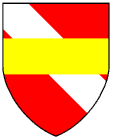
LIVES OF THE BISHOPS OF EXETER
OSBERN or OSBERT was a Norman by birth, and brother to William Fitz-Osbern, Earl of Hereford, a principal commander in the battle of Hastings, and styled by Ordericus Vitalis, "Dapifer Normanniæ, Regis Vicarius et magister militum bellicosus," (lib. iv.). The historian of Jumieges Abbey says of him, " Ipse cum Willielmo duce, Anglos maximè perdomuit, et comitatum Herefordiæ cum magnâ parte regni sensu et viribus obtinuit." The earl was the founder of St. Mary's Abbey of Lire, in the diocese of Evreux, and of St. Mary's at Cormeilles, in the diocese of Lisieux. Falling in the battle of Bavinchove, near Cassell, 22nd Feb. 1071, he was buried at Cormeilles. His wife Adeliza was interred at Lire. Sir Henry Spelman in his 'Glossary,' part I. p. 409, considers him to have been the first chief justice of England. (See Ordericus Vitalis, lib. iv.) Osbern had left his native country to reside in the court of Edward the Confessor, to whom he was nearly related, " quippe qui cognationem regiam vicino attingeret gradu." (Will. of Malm. 'De Gestis Pont,' p. 145.) As chaplain to that sovereign he had the satisfaction of witnessing the dedication of the church of Westminster Abbey, and its charter of privileges granted by the royal saint on 28th December, 1065.
Osbern was consecrated at St. Paul's, London, on 28th March, 1073, as successor to Leofric in the see of Exeter, by the primate Lanfranc; and at Easter that year assisted at the Council - begun to be holden in the Royal Chapel within Winchester Castle and completed at Pentecost at Windsor - to join his episcopal brethren in their confirmation of the primacy of Canterbury (Wilkins' 'Concilia,' vol. i. p. 325), to which King William, his Queen Matilda, Hubert the Papal Legate, Lanfranc Archbishop of Canterbury, and Thomas Archbishop of York added their signatures. We meet him again at the Council of London in 1075. The Domesday Survey, commenced and finished in his time, shows, that besides the possessions of his see in Devon and Cornwall, he had landed property also in Sussex, Surrey, Hants, Berks, Gloucester, Norfolk, and Oxfordshire. In his time Exeter must have greatly increased in population and prosperity; for King William the Conqueror allowed a sum to be paid for ever from the city taxes at Easter and Martinmas to its twenty-nine chapels. William of Malmesbury admires him for the decided preference which he manifested for the simplicity of English manners and habits, for his personal frugality, for his bounty to the poor, and his blameless character. It would seem that in advanced life he exhibited an unpleasant feeling to a colony of monks from Battle Abbey, that had settled themselves in St. Nicholas' Minster here; but on receiving the letter of Pope Paschal II., directing him to allow to the members of that, community the right of sepulture within their own inclosure, and to extend to that establishment his fostering care and protection (Wilkins' 'Concilia,' vol. i. p. 378), - and again the paternal appeal of his primate St. Anselm, to suffer them to ring their bells according to the regulations of the Benedictine order, and to encourage the faithful to assist them in completing their conventual church, - he was induced to befriend and patronise the strangers, as we have shown in the Monasticon of the diocese (Article St. Nicholas' Priory). We further learn from its chartulary that he confirmed to them the church of Collumpton (No. 13), and also the appropriation of Hydon (No. 390).
Blindness and bodily infirmity prevented this venerable prelate from assisting at the Council holden in London in the autumn of 1102: late in the ensuing year he meekly surrendered his soul to God. Of the place of his burial we collect nothing authentic.
In a document within the cathedral archives is a deed of Leowine, a priest and canon of the church of St. Mary and St. Peter of Exeter, in which he bequeaths to it - "pro animâ Osberti Episcopi et suâ," the text of the Gospels; a silver chalice, gilt inside and out, weighing two marks and fifteen pence; silver cruets, weighing sixteen shillings and eight pence; a silver thurible, gilt outside, weighing eleven marks and fifty-five pence; a silver dish, weighing three marks four shillings and four pence; a pixis or ciborium, gilt inside and out, "ad corpus Domini reservandum;" and a silver processional cross, set with precious stones and inclosing relics, with some other pious memorials. He concludes thus, "Si quis vero aliquid istorum (nisi in usus pauperum, tempore famis, expendatur) prædictæ ecclesiæ subtraxerit, perpetuæ subjaceat maledictioni - Amen. Fiat. Fiat. Amen."
Arms: - Gules, a bend argent, surmounted by a fess or.
